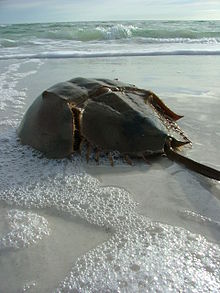Structural Biochemistry/Comparison of Vertebrate and Invertebrate Proteolytic Cascades
Though the proteins involved in the immune cascades differ across species, the overall roles of invertebrate and vertebrate proteolytic cascades are essentially the same. Investigation of the innate immune systems and complement systems enable us to learn mechanisms of how invertebrates are able to combat presence of microorganisms. Comparison of several phyla of invertebrate systems to vertebrate systems offers an insight to the evolutionary directions that occurred that led to the characteristics and mechanisms seen today in invertebrates and vertebrates.
Comparison of Vertebrate Innate Immune Response to Vertebrate Coagulation:
Horseshoe Crab Coagulation vs. Vertebrate Coagulation

Horseshoe crabs produce a gel that traps small foreign antigens via a proteolytic cascade that occurs in which bacterial lipopolysachharide (LPS), a part of the outer membrane of a bacterial antigen, binds to a cell-surface protein Factor C on a granular hemocyte containing inactive hemolymph. LPS’s binding to Factor C triggers the exocytosis of defense proteins.[1]
The binding site of Factor C on hemocyte cell surface has a specific tripeptide motif of two basic residues interspersed by an aromatic amino acid. Analogously, mammalian innate immune response, mammalian coagulation factors are also contained in granules before exocytosis which activate platelets.[2]
Also, phagocytic cells in mammals are able to distinguish between host cells and foreign microbes via common microbial patterns that are recognized by host proteins, called Pattern Recognition Receptors (PRRs), which operate in a way analogous to the particular PRR Factor C on hemocytes of horseshoe crabs by recognizing certain functionality or motifs on invading microbes. For example, the Macrophage Mannose receptor in mammals binds to mannose residues prevalent on the surface of antigenic microorganisms.[3] From this comparison of the innate immune system of horseshoe crabs and vertebrate mammals, it is evident that the structural characteristics of LPS-recognizing proteins across different species are conserved.
Complement System
The complement system is a cascade involving proteases, proteins that cleave peptide bonds, that “complement” the ability of antibodies to clear pathogens from an organism. The complement system is a part of immune system, specifically the innate immune system.
Vertebrate complement system (complement cascade)
The Vertebrate complement system has several serine proteases, enzymes that cleave peptide bonds in proteins that have one amino acid at the active site as a serine, involved in parallel proteolytic cascades. Proteases in the system cleave specific proteins to release cytokines, which themselves in turn, cascade more cleavages. The proteases involved in vertebrate complement system can be classified into two families, the complement factor B (Bf) and the mannose-binding lectin-associated serine protease (MASP). The Bf family includes Bf and C3 proteases. The MASP family comprises the MASP-1, MASP-2, MASP-3, C1r, and C1s proteases. In addition, the vertebrate complement system includes the C3 family of proteins, which are not proteases. C3 proteins have an intramolecular thioester bond that is revealed after proteolytic cleavage and can react with the surface of invading microbes via a PRR mechanism. Altogether, the three families form an integral part of complement activation.
Invertebrate complement system
Proteins involved in invertebrate complement system vary depending on phyla and species. However, the vertebrate Bf, C3, and MASP complement families of proteins have been generalized to their vertebrate counterparts, in reference to their common ancestral origins. The invertebrate orthologs (genes in dissimilar species that have evolved from a common ancestral gene) can be classified according to phyla. A few examples are explored in the following.
Horseshoe crab complement system

Horseshoe crabs are used an example because its complement system has been characterized functionally and biochemically. They have CrC3 (C3 ortholog) and CrBf (Bf ortholog) proteins that are structurally and functionally like their vertebrate orthologs. CrC3’s chemical structure indicates that it may be activated via a thioester bond in binding to pathogens for opsonization.
Protostomes
Protostomes are organisms having bilateral symmetry as well as three germ layers. Arthropods, nematodes, mollusks are examples. Protostomes have C3 and Bf proteases.
Ascidians
Ascidian complement system include the components Bf, MASP, glucose-binding lectin, GBL, ficolin, and integrin alpha and beta chains. These components are synthesized in its hepatopancreas. MASPs associated with GBL can proteolytically activate ascidian C3, however this activation is poor, indicating that ascidian MASP is not a major C3-activating enzyme, a distinct difference from the vertebrate complement system.
References
edit- ↑ Cerenius, L et al. (2010) Proteolytic cascades and their involvement in invertebrate immunity
- ↑ http://en.wikipedia.org/wiki/Coagulation
- ↑ http://bioweb.wku.edu/courses/biol328/innate.htm